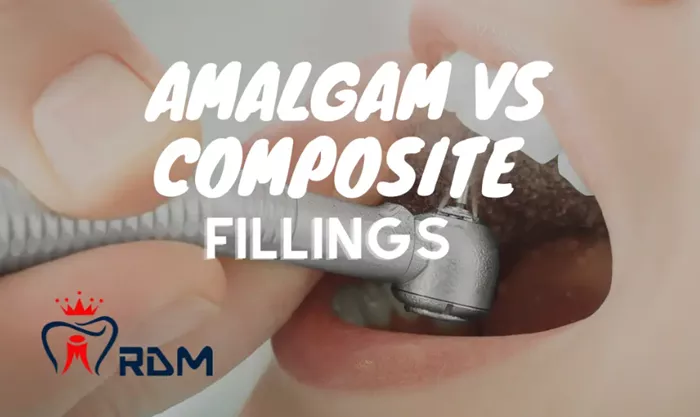Dental fillings are common treatments used to repair teeth damaged by decay or trauma. Two of the most widely used filling materials are amalgam and composite resin. Each has its own advantages and disadvantages, especially when it comes to longevity and impact on oral health.
This article compares amalgam and composite fillings in detail. We will discuss which lasts longer and how they relate to dental issues like gum inflammation and gum disease.
What Are Amalgam Fillings?
Amalgam fillings have been used for over 150 years. They are made from a mixture of metals, including silver, mercury, tin, and copper. The mercury binds the metals to create a strong, durable material.
Characteristics of Amalgam Fillings
Durability: Amalgam is very strong and can withstand heavy chewing forces.
Longevity: These fillings often last 10 to 15 years or more.
Appearance: They are silver or dark gray, making them visible when you smile.
Cost: Generally, amalgam fillings cost less than composites.
What Are Composite Fillings?
Composite fillings are made of a tooth-colored resin that blends well with natural teeth. They have become popular due to their aesthetic appeal and improvements in their durability over time.
Characteristics of Composite Fillings
Appearance: Composite matches the color of your teeth, making it less noticeable.
Bonding: It bonds directly to the tooth, which can help support the remaining tooth structure.
Durability: Modern composites can last 5 to 10 years, sometimes longer with good care.
Cost: Usually more expensive than amalgam fillings.
Comparing the Longevity of Amalgam and Composite Fillings
The key question is: Which filling lasts longer? Several factors influence the lifespan of a filling, such as location in the mouth, size of the cavity, oral hygiene, and habits like teeth grinding.
Durability and Wear Resistance
Amalgam fillings are generally tougher and more wear-resistant. They handle strong chewing forces well, especially in the back molars. Amalgam is less likely to chip or wear down quickly.
Composite fillings, while improved, are less resistant to heavy wear. They can chip or crack, especially in large restorations or in patients who grind their teeth.
Lifespan Estimates
Amalgam: Typically lasts 10 to 15 years; some last up to 20 years with excellent care.
Composite: Usually lasts 5 to 10 years; some may last longer but often need replacement sooner than amalgam.
Replacement and Maintenance
Composite fillings may require more frequent replacement due to wear, staining, or minor fractures. Amalgam fillings often remain intact longer but might cause cracks in teeth over decades due to metal expansion and contraction.
Impact on Gum Health: Gum Inflammation and Gum Disease
Fillings do not directly cause gum inflammation or gum disease. However, poorly placed or damaged fillings can contribute to plaque buildup and irritation of the gums.
Amalgam Fillings and Gum Health
Amalgam fillings have a smooth surface but can sometimes cause minor gum irritation if the edges are not properly sealed or if they extend too close to the gum line. Additionally, mercury concerns have been raised, but research shows that amalgam fillings are generally safe when placed correctly.
Composite Fillings and Gum Health
Composite fillings bond to the tooth and can be shaped closely to natural contours, helping maintain healthy gums. However, they are more prone to staining and plaque accumulation if rough or chipped, which can promote gum inflammation if oral hygiene is poor.
Proper Oral Hygiene Is Key
Regardless of filling type, regular brushing, flossing, and dental visits help prevent gum disease. Early-stage gum inflammation (gingivitis) can be reversed before it progresses to more severe periodontal disease.
Other Dental Considerations
Tooth Structure Preservation
Composite fillings require less removal of healthy tooth structure because they bond directly to the tooth. Amalgam fillings often require removing more tooth material to create space for the filling to stay in place.
Appearance and Patient Preferences
Many patients prefer composite fillings for front teeth or visible areas due to their natural look. Amalgam is often chosen for back teeth where appearance is less critical, and strength is more important.
Sensitivity and Post-Treatment Care
Some patients report temporary sensitivity after both types of fillings. Composites can sometimes cause more sensitivity due to the bonding process, but this usually subsides. Proper placement and good dental care reduce complications.
Environmental and Safety Considerations
Amalgam contains mercury, which requires careful handling and disposal by dental professionals. Some patients worry about mercury exposure, but studies show that mercury levels released by fillings are very low and considered safe.
Composite fillings do not contain mercury but may release small amounts of other chemicals. Both materials are regulated for safety by health authorities worldwide.
Cost Comparison
Amalgam fillings are usually less expensive because the material is cheaper and the placement process is quicker. Composite fillings cost more due to the material price and the longer time needed for placement.
Choosing Between Amalgam and Composite Fillings
Choosing the right filling depends on many factors including:
- Location of the cavity
- Size and depth of the decay
- Patient’s bite and habits
- Esthetic concerns
- Budget
- Potential impact on gums and oral health
Discussing options with your dentist helps you make the best choice for your specific situation.
Conclusion
In terms of durability and lifespan, amalgam fillings typically last longer than composite fillings, especially in areas of heavy chewing pressure. However, composite fillings offer superior aesthetics and bond well to teeth, preserving more healthy structure.
Both types of fillings require good oral hygiene to prevent complications such as gum inflammation and gum disease. Regular dental check-ups ensure fillings remain intact and gums stay healthy. Ultimately, the choice between amalgam and composite fillings depends on individual needs, preferences, and professional dental advice.

